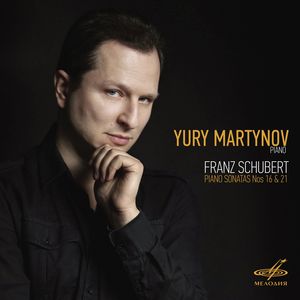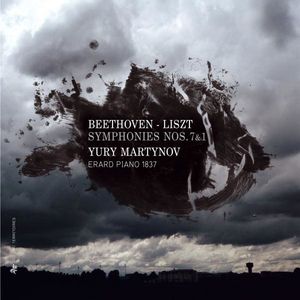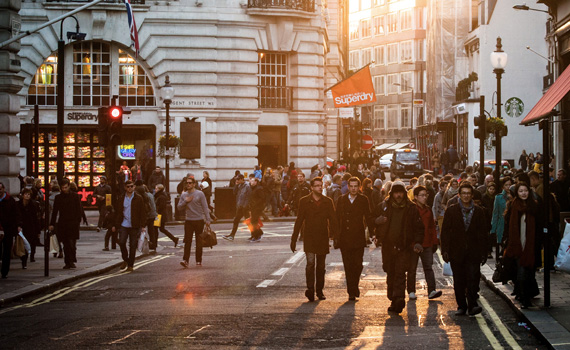Л. ван Бетховен - Ф. Лист, Симфонии №9 - Рецензии

ЛЮДВИГ ВАН БЕТХОЕН - ФЕРЕНЦ ЛИСТ
СИМФОНИЯ No. 9 РЕ МИНОР Op. 125

After four previous discs devoted to Franz Liszt`s transcriptions of the Beethoven symphonies, the pianist Yury Martynov completes the cycle with the transcription of the Ninth Symphony. The reduction of this complex work for a single piano and two hands – he had already adapted it for two pianos – constituted a genuine challenge for Liszt, who was obliged to omit certain inner parts. Yet he succeeded in reproducing the symphony’s prodigious character and revealing its incredible power. The piano combines the orchestra, the soloists and the chorus, unifying these disparate voices in a single instrument. The work’s energy and its textures are displayed to the full in Yury Martynov’s performance on a Blüthner piano dating from 1867 and belonging to the Edwin Beunk collection.
Après quatre premiers disques consacrés aux transcriptions des symphonies de Beethoven par Franz Liszt, le pianiste Yury Martynov complète ce cycle avec la transcription de la Neuvième Symphonie. OEuvre complexe d’abord adaptée pour deux pianos, sa réduction au piano seul et à deux mains constitue un véritable défi pour Liszt, qui se voit contraint d’en sacrifier certaines parties. Il parvient toutefois à restituer le caractère prodigieux de cette oeuvre, en révèle l’incroyable puissance. Le piano réunit l’orchestre, les solistes et le choeur, unifiant ainsi leurs voix dans un même instrument. L’énergie ainsi que l’écriture de la symphonie s’en trouvent dévoilées et magnifiées, à travers l’interprétation de Yury Martynov sur un piano Blu¨thner datant de 1867, issu de la collection d’Edwin Beunk.
GRAMOPHONE, Patrick Rucker, April 2016
«With this release, Yury Martynov wraps up his traversal of Liszt’s transcriptions of all nine Beethoven symphonies, the first complete set to use historical instruments (an 1837 Erard and a Blüthner, c1867). In many ways, Martynov’s wide experience with a variety of historical keyboards and styles made him ideally suited to so ambitious a project. But what seems especially striking is that the high standards established with the first instalment in 2012 have not been maintained but surpassed.
Yury Martynov is one of the few pianists around with the technical resources, musical grasp and conviction to recreate this legacy persuasively. In doing so, he amply demonstrates its continued usefulness and vitality. It seems safe to say that he has given us the Beethoven-Liszt cycle for our time, and one unlikely soon to be superseded.»
читать статью
MUSICWEB, Domini Clements, 14 March 2016
Yury Martynov on his old Blüthner can stand amongst the best of any recordings on newer instruments, and as a performance in sounds that would have been home turf to its creator this has to be a leading choice.
RADIO CLASSIQUE, Stéphane Friédérich, March 2016
QUAND LE PIANO DEVIENT ORCHESTRE
L’oreille de Liszt, les doigts de Martynov et les couleurs de son piano historique exaltent la grandeur visionnaire de Beethoven.
Quel orchestre ! Pardon : quel pianiste !
THE NEW LISTENER, Hans von Koch, March 2016
Den goldenen Apfel bekommt jedoch Martynov, vor allem auch wegen des wunderbar weichen und doch so farbig-obertonreichen Klangs des historischen Blüthner-Flügels, gespielt in der für ihre Akustik weltberühmten Doopsgezinde Kerk von Haarlem (NL). Für mich sind (die leider so seltenen) Aufführungen auf Blüthner-Flügeln immer etwas ganz Besonderes, und ich kann uns allen nur wünschen: Mehr Martynow, mehr Blüthner … !
читать статью
LE BABILLARD, Loïc Chahine, 14 February 2016
Yuri Martynov sait l’exploiter à fond, le faire miroiter doucement comme le pousser au bord de l’explosion, lancer les graves comme des bombes et les aigus comme des fusées. C’est véritablement un feu d’artifice, car on s’étonne jusqu’à la fin de la variété des couleurs dont l’instrument et l’instrumentiste nous régalent.
On en vient à regretter que Liszt (et Yury Martynov) n’ai(en)t pas fait la même chose avec les symphonies de Mahler.
читать статью
THE GUARDIAN, Andrew Clements, 11 February 2016
A PIANISTIC TOUR DE FORCE IN MARTYNOV`S HANDS
It took a persuasive letter from his publisher to get him to finish what he had started, and the result, in Martynov’s exceptional hands, is thrilling and remarkable. It’s no substitute for the splendours of the original, of course, but it is an authentic musical experience in its own right, and a real pianistic tour de force. The double fugue at the climax of the finale is especially dazzling, and Martynov’s handling of it equally remarkable, and in all four movements there are details usually obscured in orchestral performances which come to light, thanks to his meticulous phrasing and colouring of every bar.
MUSIKZEN, Pablo Galonce, 17 February 2016
ODE À LA JOIE DU PIANO
YURY MARTYNOV TERMINE EN APOTHÉOSE SON INTÉGRALE BEETHOVEN/LISZT
..son interprétation est si intense qu`on finit bien par oublier l’original..
ALL MUSIC, Blair Sanderson, 17 March 2016
Perhaps no musician in the 19th century was a greater promoter of the symphonies of Ludwig van Beethoven than Franz Liszt, who not only conducted them regularly in Weimar, but made piano transcriptions of all nine, which were published together in 1865. The keyboard version of the Symphony No. 9 in D minor, "Choral," was one of the most challenging for Liszt, who agonized over making a viable arrangement of the complex choral finale, the famous setting of Schiller`s Ode to Joy. Yet Liszt`s bravura transcription was a success, and the Ninth was made available to musicians and listeners who, in the age before recordings, were unable to hear this work any other way. For this recording, Yury Martynov has recorded Liszt`s reduction on a Blüthner piano, ca.1867, which gives a good idea of the sonorities he would have known, though for his own performances he favored a Bösendorfer, which could withstand his powerful playing. This recording shows that the Blüthner piano is a good choice, and Martynov holds nothing back in his virtuoso performance, which offers many thrilling passages. The sound of this Alpha CD is well balanced and gives a fairly close-up impression of Martynov's playing, though there is enough space between the piano and the microphone to let the resonant church acoustics have an effect.
СONCERTI, Christoph Vratz, 2016
Unmittelbar und technisch über alle Zweifel erhaben: Yury Martynov komplettiert mit der Neunten seine Beethoven-Edition
Das gesamte Projekt verdient eine Auszeichnung. Yury Martynov hat als erster Pianist Beethovens neun Sinfonien in der Liszt-Bearbeitung an (verschiedenen) historischen Flügeln aufgenommen. Nun steht diese Edition neben den Einspielungen mit Scherbakow, Biret und Katsaris. Martynov sitzt nicht nur an Flügeln des 19. Jahrhunderts, er hat auch ihre entsprechenden Spielweisen verinnerlicht. Das ihm ermöglicht oft zügige bis rasante Tempi und schroffe Kontraste. Doch ist Martynov klug genug, darüber nicht die großen Linien zu vergessen. Sein Spiel ist unmittelbar und technisch über alle Zweifel erhaben, im Leisen kann er geheimnisvoll flüstern und schattieren. In Akkordgewittern vergisst er nicht die erforderliche Leuchtkraft im Diskant. Davon zeugt nun auch die Aufnahme der Neunten, aufgenommen auf einem Blüthner-Flügel von ca. 1867. Beethovens sinfonischer Geist wurde großartig eingefangen.
Open-air in Podmoklovo: youtu.be/aGJf1OGx0uU?a на @YouTube
Ulyanovsk. Mozart concerto #20 https://t.co/wtokVMiYth
My new website is now live!
instagram.com/p/BT1zBEghehs/https://t.co/dO4DndwPXi
Yury Martynov in Kaluga (Nika-TV): youtu.be/fhrzcaInZEU?a на @YouTube
Подпишитесь здесь на рассылку Юрия!
Open-air in Podmoklovo: youtu.be/aGJf1OGx0uU?a на @YouTube
Ulyanovsk. Mozart concerto #20 https://t.co/wtokVMiYth
Подпишитесь здесь на рассылку Юрия!








